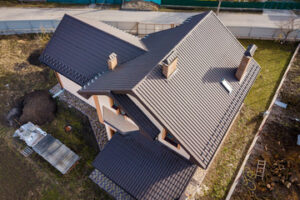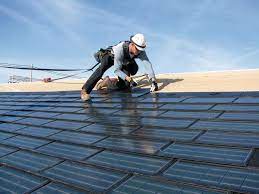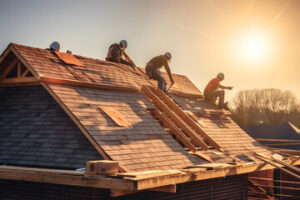Shingle roofs should be inspected annually by homeowners and by roofing professionals. This allows you to spot problem areas and address them before they turn into significant issues like leaks.

Inspect for damage to shingles, caulking, and flashing. Maintain clean gutters to prevent clogs. In the winter, ensure adequate ventilation and ice dam protection. Trim tree branches that encroach on your roof and cut back landscaping like shrubs. Keep reading the article below to Learn More.
The flashings on a roof play an important role in keeping water out of your home. Unfortunately, they can become damaged due to serious weather conditions or from a lack of regular maintenance. Fortunately, most damage to roof flashings is preventable and can be repaired in a timely fashion.
Visible rust or corrosion in the flashings is often an indicator that it is deteriorating. This can occur around areas where the flashing meets other roofing materials or where it overlaps with shingles. If left unattended, the rust will eventually allow moisture to penetrate the roof and cause leaks throughout the home.
Another common sign of deteriorating flashing is water pooling on the roof or inside the home. This can be especially dangerous if the pooling occurs in places where rainwater is supposed to channel away from the roof such as dormers, roof valleys or where the siding meets the roof.
When water reaches these vulnerable spots, it can lead to mold and mildew growth and create health hazards for household occupants. It can also reduce energy efficiency and lower the value of your home.
A simple repair to fix this issue is to seal the leaky areas with a high-quality roof sealant or caulk. These can be purchased at most hardware stores and come in a variety of formulations. Choose a sealant or caulk that is specifically designed for roofing applications and follow the manufacturer’s instructions for application and drying time.
It’s also a good idea to keep detailed records of any roof flashing repairs, including before-and-after photos and measurements. This documentation can be useful for future reference, warranty claims or when selling your home. This is an excellent way to maintain proper roof maintenance and help you avoid costly and inconvenient problems in the future. In cases where the flashing is severely damaged, or the temporary solutions mentioned above are insufficient, a professional roofing contractor should be consulted for immediate and long-lasting repair. They have the expertise, specialized tools and experience to accurately assess the damage and provide appropriate repair services to protect your home.
Sagging or Unevenness
A sagging roofline is a serious problem that requires professional inspection and repairs to avoid structural damage. It also exacerbates other issues like leaks and mold growth, and can reduce the value of a home.
A common cause of roof sagging is normal wear and tear over time. This can include deterioration of shingles, underlayment, or even the roof framing. It’s important to inspect your roof regularly, especially after storms or heavy snowfall.
In other cases, a sagging roof is caused by structural problems. If the rafters or trusses are damaged, rotted, or improperly installed, they may not be able to support the weight of the structure.
Poor ventilation is another common cause of sagging roofs. It can lead to moisture buildup, which can weaken the wooden rafters and supports over time. This can make the roof sag, and it’s crucial to ensure proper attic ventilation to prevent sagging and other structural problems.
Sagging roofs require specialized skills and tools to repair properly. A ladder is essential to safely access the roof, and a level can help you accurately measure the severity of the sagging. In addition, you’ll need a hammer and nails, and plywood to reinforce the roof and prevent future sagging. It’s always best to consult a professional roofing contractor when dealing with significant roof sagging, as they can provide expert assessments and recommendations. They can also install additional supports to reinforce the roof and prevent further damage. They can also replace rotting or damaged wood, and add braces to the existing structure to improve stability and prevent sagging in the future. In some cases, they may recommend installing steel beams to increase durability and longevity. This can be a more expensive option than using lumber, but it offers superior strength and resistance to sagging and other structural issues.
Poor Ventilation
A well-ventilated attic prevents heat buildup in the summer and helps ward off ice dams during winter. However, a lack of ventilation can cause excessive moisture to collect under the roof, leading to wood rot and compromised indoor air quality. If left unchecked, poor ventilation can compromise the structural integrity of your home and void your roofing material warranty.
The most obvious sign of inadequate attic ventilation is visible moisture damage to the rafters, plywood, and ceilings in living spaces below the attic. This moisture is caused by warm, rising air that saturates attic insulation and causes water vapor to condense on cold surfaces. When this moisture is not removed, it can lead to rotting and premature failure of roof decking, shingles, and underlayment. It can also damage stored items and create a breeding ground for mold and mildew, which is not only unsightly but poses health concerns.
Moreover, insufficient attic ventilation can cause energy costs to skyrocket by overburdening the air conditioning system. Inconsistent indoor temperatures are another warning sign, particularly overheating in upper rooms and a noticeable change in temperature from room to room. A professional roofing contractor will conduct a thorough inspection and recommend the proper solution to restore a healthy ventilation system.
For most homes, a single vent per 150-300 square feet of attic space is sufficient. However, the type and number of vents required depends on a number of factors, including climate, attic size, and home design. In some cases, it may be necessary to install ridge or soffit vents along the roof peak and soffits at the eaves for improved air intake. For some homeowners, a powered vent like an attic fan may be recommended to help keep the attic adequately ventilated and reduce air conditioning strain.
Proper attic ventilation is essential to the longevity of your roofing materials, a safe living environment, and energy efficiency. It is crucial to perform regular maintenance to check that the vents are not obstructed or damaged, and have the attic insulated properly. A professional roofer can help you ensure that your attic is properly ventilated and provide expert advice to keep it in good working condition.
Clogged Gutters
Your gutters are designed to direct rainwater and snow melt away from your home’s roof. If your gutters become clogged, this can cause serious problems throughout your house and require costly repair.
The most obvious sign of a clogged gutter is water spilling over the sides of your gutters during a rainstorm rather than flowing through downspouts and away from your property. This can lead to roof leaks, rotting fascia boards, and other structural issues. The accumulated rainwater can also pool around your foundation, creating cracks and basement flooding.
Clogged gutters also create the ideal environment for insects and rodents to breed. Damp leaves and other debris offer food, shelter, and breeding grounds for pests that can chew through roofing materials, electrical wiring, and even enter your home.
If your gutters aren’t functioning properly, it may be time to replace them. Look for signs of damage, including holes, cracks, or disconnected joints, as well as rust and corrosion. If you notice any of these problems, sand the damaged area, then patch the hole using an adhesive roof patch or sealant specific to metal gutters. You can also use a rust-inhibiting primer and reseal the entire gutter system for added protection.
Gutter downspouts are often the source of clogs, as leaves, twigs, seeds, and other debris can get caught in the downspout and block water flow. Check the downspout for a cage or wire strainer, which helps to trap larger items while allowing water to flow through. Downspout elbows, seams, and downspout hangers can also be prone to clogging. You can test a downspout for a clog by tapping it with a screwdriver and listening for a dull thud, which indicates the location of the clog.
Properly functioning gutters should be sloped so that water runoff carries away from your foundation at least ten feet. If your gutters are clogged, they may be draining closer than this to the foundation of your home, leading to damp walls and mold growth within living spaces. Water leaking through basement walls and into storage areas can also ruin furniture and other belongings, as well as cause structural problems and flood your home’s living spaces.

